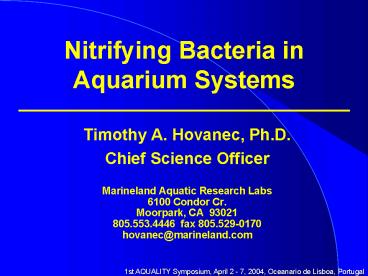Nitrifying Bacteria in Aquarium Systems - PowerPoint PPT Presentation
1 / 25
Title:
Nitrifying Bacteria in Aquarium Systems
Description:
Nitrospira sp. Nitrospira marina. Gallionella ferruginea ... What's the Practical Application? Just different names for basically the same bacteria ... – PowerPoint PPT presentation
Number of Views:649
Avg rating:3.0/5.0
Title: Nitrifying Bacteria in Aquarium Systems
1
Nitrifying Bacteria in Aquarium Systems
- Timothy A. Hovanec, Ph.D.
- Chief Science Officer
- Marineland Aquatic Research Labs
- 6100 Condor Cr.
- Moorpark, CA 93021
- 805.553.4446 fax 805.529-0170
- hovanec_at_marineland.com
2
Nitrification
Ammonia (NH )
3
Nitrite (NO2-)
Nitrosomonas europaea
Nitrate (NO3-)
Nitrobacter winogradskyi
3
Lots of Assumptions
- Same bacteria in freshwater and saltwater
systems - Nitrosomonas europaea was the AOB
- Nitrobacter winogradskyi was the NOB
- Spotte 1971
- normal concentration of seawater, nitrification
in freshwater systems stopped altogether - Bower Holm-Hansen 1972
- Bacterial based products for accelerating
nitrification were ineffective - Johnson Sieburth 1976
- Using SEM failed to find evidence of traditional
nitrifiers in filters from fresh and saltwater
aquaculture operations
4
Ammonia-Oxidizing Bacteria
- Teske et al 1994
- Evolutionary relationships in AOB and NOB
- Mobarry et al 1996
- Phylogenetic probes for ammonia-oxidizing
bacteria - Hovanec and DeLong 1996
- Nitrosomonas europaea not found in freshwater
aquaria - Nitrobacter winogradskyi not found in fresh/salt
aquaria - Juretschko et al 1998
- Nitrosococcus mobilis Nitrospira-like in
activated sludge - Schramm et al 1998
- Nitrosospira Nitrospira-like dominant in
fluidized bed - Burrell, Phalen Hovanec 2001
- Novel AOB in freshwater aquaria
available at http//journals.asm.org
5
Nitrospira Nitrite-Oxidizing Bacteria
AEM - Applied and Environmental
Microbiology, published by the American Society
for Microbiology
6
Phylogenetic Relationships of AOB NOB
Delta subdivision
Alpha subdivision
Nitrospira phylum
Rhodopseudomonas palustris
Nitrobacter winogradskyi
Nitrospina gracilis
Magnetobacterium bavaricum
Gamma subdivision
Leptospirillum ferrooxidans
Nitrospira sp.
Nitrococcus mobilis
Nitrospira marina
Nitrosococcus oceanus
Thiobacillus ferrooxidans
Nitrosospira briensis
Nitrosovibrio tenuis
Gallionella ferruginea
Nitrosospira multiformis
Nitrosococcus mobilis
Nitrosomonas nitrosa
Nitrosomonas halophila
Nitrosomonas cryotolerans
Nitrosomonas eutropha
Nitrosomonas marina
Nitrosomonas europaea
Beta subdivision
7
Koops et al 2003. The Lithoautotrophic
Ammonia-oxidizing bacteria. In The Prokaryotes
An Evolving Electronic Resource for the
Microbiological Community. http//link.springer-n
v.com/link/service/books/10125/
8
Phylogenetic Classification of beta-subclass AOB
Adapted Purkhold et al. 2000. AEM 66(12)
5368-5382
9
Whats the Practical Application?
- Just different names for basically the same
bacteria - Same process that will naturally occur
- Bacteria behave differently in the real World
10
Ecology of Nitrifying Bacteria
- Are freshwater-saltwater nitrifiers the same How
to accurately count them - Where do they prefer to live
- Do they have a bio-material preference
- Do the AOB and NOB communicate
- Does species composition change with time
- Can they be massed produced
- Affects of water chemistry (i.e., TOC)
11
Methods and Materials
12
N. briensis
FRESH AMMONIA OXIDIZERS
N. multiformis
N. tenuis
N. tenuis
BF16c39
R5c49
R3c5
R19c8
R5c52
Nitrosospira
R3c48
Cluster B AOB
cluster
R3c35
R5c78
BF16c23
BF16c32
BF16c14
BF16c35
BF16c37
BF16c46
BF16c49
BF16c59
N. europaea
R3c12
R5c47
R5c88
N. europaea
R5c99
R19c51
Nc. mobilis
N. eutropha
NM 104
cluster
NM 107
BF16c52
Nc. mobilis
N. halophila
N. communis
NM 33
N. communis
cluster
N. nitrosa
NM 41
N. marina
NM 51
N. marina
N. aestuarii
BF16c57
R19c90
N. marina
cluster
BC5c107
R7c131
Cluster A AOB
R7c140
R7c5
R7c129
R7c154
N. ureae
N. oligotropha
cluster
N. oligotropha
N. cryotolerans
cluster
N. cryotolerans
T. thioparus
0.005 substitutions/site
13
N. briensis
N. tenuis
Nitrosospira
N. multiformis
N. tenuis
cluster
N. tenuis
R29c99
R29c40
N. europaea
N. eutropha
N. halophila
R29c64
P4c40
R29c29
N. europaea
SALT AMMONIA OXIDIZERS
/
R29c31
Nc. mobilis
R29c147
cluster
R29c124
R29c108
NM 104
NM 107
Nc. mobilis
Nc. mobilis
N. marina
NM 51
N. marina
N. marina
N. aestuarii
P4c22
P4c41
P4c2
N. marina
cluster
P4c31
P4c15
P4cB14
P4cB4
P4c42
P4cB27
P4cB18
P4cB28
freshwater Cluster A AOB
R21c9
N. oligotropha
cluster
N. ureae
N. oligotropha
N. cryotolerans
cluster
N. cryotolerans
N. communis
N. communis
cluster
NM 33
N. nitrosa
NM 41
T. thioparus
0.005 substitutions/site
14
Nitrite-oxidizing bacteria in aquaria
15
Nitrification in FW Aquaria
Ammonia (NH )
3
Nitrite (NO2-)
Nitrosomonas marina-like and Nitrosospira
Nitrate (NO3-)
Nitrospira-like
16
Nitrification in Saltwater Aquaria
Ammonia (NH )
3
Nitrite (NO2-)
Nitrosomonas aestuarii-like and N. halophila-like
Nitrate (NO3-)
Nitrospira marina-like
17
Counting -Freshwater Nitrifiers
18
View of saltwater biofilm with AOB (green) and
NOB (red) by FISH (1,250x).
19
Starting a New Aquarium
- Mean of 4 aquaria
- 8 rosy barbs
- Mixture of novel freshwater AOB and NOB
- established 10 D
- Not above 3 mg/L
20
Testing in Newly Set-up Marine Aquaria
Mean (N4) ammonia (A) and nitrite (B) trends in
newly set-up saltwater aquaria dosed with N.
aestuarii-like AOB (red) or N. halophila-like AOB
(green) versus control (blue) which received no
bacteria. NOB was Nitrospira marina-like in both
bacterial treatments.
21
Testing in newly set-up aquaria with clownfish
22
Species changes over time and conditions
23
Mass Production of Nitrifiers
24
Sum up - what weve learned
- At most 20 of bacterial biomass on a biofilter,
but usually 2-5 - Nitrifiers grow more slowly in saltwater
- spend energy maintaining turgur pressure
- (Oren, A. Micro Mol Biol. Rev. 1999.
63334-348) - NOB grow more slowly than AOB
- will see nitrite before ammonia when problems are
developing - Around 10C and below species shift
- Grow as floccs when happiest, when stressed
floccs break-up and cells separate
25
Thanks to my Lab Staff































